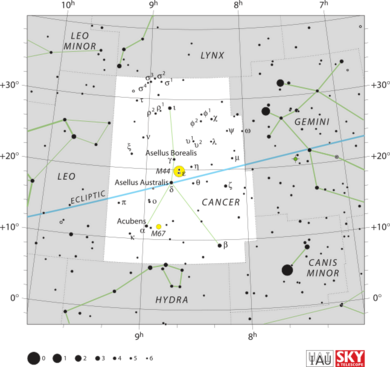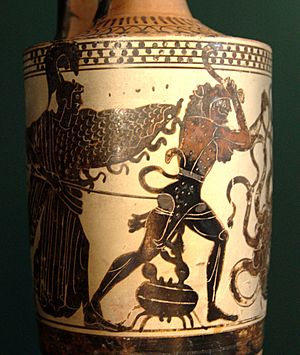Cancer (constellation) facts for kids
| Constellation | |

List of stars in Cancer
|
|
| Abbreviation | Cnc |
|---|---|
| Genitive | Cancri |
| Pronunciation | genitive |
| Symbolism | the Crab |
| Right ascension | 07h 55m 19.7973s–09h 22m 35.0364s |
| Declination | 33.1415138°–6.4700689° |
| Area | 506 sq. deg. (31st) |
| Main stars | 5 |
| Bayer/Flamsteed stars |
76 |
| Stars with planets | 10 |
| Stars brighter than 3.00m | 0 |
| Stars within 10.00 pc (32.62 ly) | 2 |
| Brightest star | β Cnc (Altarf) (3.53m) |
| Messier objects | 2 |
| Meteor showers | Delta Cancrids |
| Bordering constellations |
Lynx Gemini Canis Minor Hydra Leo Leo Minor (corner) |
| Visible at latitudes between +90° and −60°. Best visible at 21:00 (9 p.m.) during the month of March. |
|
Cancer is one of the twelve constellations that make up the zodiac. Its name comes from Latin and means "crab." It is often shown as a crab. The symbol for Cancer looks like the pincers of a crab.
Cancer is a medium-sized constellation. It covers 506 square degrees of the sky. Its stars are not very bright. The brightest star, Beta Cancri, has a brightness of 3.5. Cancer has two stars with known planets. One of these, 55 Cancri, has five planets! One of these planets is a "super-Earth." Four others are gas giants. One gas giant is in the "habitable zone." This means it could have temperatures like Earth. In the middle of Cancer is the Beehive Cluster, also called Praesepe. This is a group of stars that is close to Earth. It is a popular target for people who like to look at the sky with telescopes.
Contents
What is the Cancer Constellation Like?
Cancer is a medium-sized constellation. It is next to Gemini on the west. To the north is Lynx. Leo Minor is to the northeast. Leo is to the east. Hydra is to the south. Canis Minor is to the southwest.
The short name for Cancer is 'Cnc'. This was chosen by astronomers in 1922. Cancer covers about 0.921% of the whole sky. It is the 31st largest constellation. You can see Cancer from almost anywhere on Earth. It is best seen at 9 p.m. in March.
What are the Cool Things in Cancer?
Stars in Cancer
Cancer is the dimmest of the zodiac constellations. It only has two stars brighter than magnitude 4. This means most of its stars are quite faint.
Beta Cancri, also called Altarf, is the brightest star in Cancer. It has a brightness of 3.5. It is about 290 light-years from Earth. Altarf is a binary star system. This means it is made of two stars orbiting each other. The main star is an orange giant. It is about 50 times bigger than our Sun. It shines with 660 times the Sun's light. It has a tiny, dim companion star. This companion takes 76,000 years to orbit Altarf. Altarf represents part of the crab's body.
Delta Cancri, also known as Asellus Australis, is an orange giant star. It is about 136 light-years from Earth. Its common name means "southern donkey." This star also has a very long ancient Babylonian name. It means "the southeast star in the Crab."
Gamma Cancri, or Asellus Borealis, means "northern donkey colt." It is a white star about 158 light-years from Earth.
Iota Cancri is a wide double star. The main star is a yellow giant. It is about 298 light-years from Earth. The second star is a white star. You can easily see both with a small telescope.
Alpha Cancri (Acubens) is another double star. It is about 173 light-years from Earth. Its common name means "the claw." The main star is a white dwarf.
Zeta Cancri or Tegmine means "the shell." It is a multiple star system. This means it has at least four stars! They are about 83 light-years from Earth. The two brightest stars orbit each other every 1100 years.
Rho-1 Cancri, or 55 Cancri, is a binary star system. It is about 40.9 light-years from Earth. It has a yellow dwarf star and a smaller red dwarf star. Five planets orbit the yellow dwarf star. One planet is a low-mass world. It might be hot and rich in water, or a carbon planet. The other four are gas giants.
Deep-Sky Objects in Cancer
Cancer is famous for the Beehive Cluster, also called Praesepe. This is an open cluster of stars. It is right in the middle of the constellation. It is about 577 light-years from Earth. This makes it one of the closest open clusters to our Solar System. The Beehive Cluster has about 50 stars. The brightest stars are visible with binoculars. It is also one of the larger open clusters. It looks three times bigger than the full Moon in the sky.
Ancient Greeks and Romans thought the Beehive Cluster looked like a manger. Two donkeys, represented by nearby stars, were eating from it. The donkeys were said to be ridden by the god Dionysus and his teacher Silenus. They rode them in a war against the Titans. The ancient Chinese saw it as a "cloud of pollen."
Another open cluster in Cancer is Messier 67. It is about 2500 light-years from Earth. It is about the size of the full Moon. It has about 200 stars. The brightest stars are quite dim.
OJ 287 is a very interesting object. It is a type of BL Lac object. It is located 3.5 billion light-years away. It has shown bright flashes of light for about 120 years. Its central supermassive black hole is one of the biggest known. It is 18 billion times the mass of our Sun!
How Old is the Cancer Constellation?
In ancient times, Cancer was important. It was where the Sun was during the summer solstice. This is the longest day of the year. This happens around June 21. Because of how Earth wobbles, the summer solstice now happens when the Sun is in the constellation Taurus. The line on Earth where the Sun is directly overhead during the summer solstice is called the Tropic of Cancer.
In Greek mythology, Cancer is linked to a story about Hercules. Hercules was fighting the many-headed Hydra. A crab came and bit Hercules on the foot. Hercules quickly crushed the crab. The goddess Hera, who did not like Hercules, then placed the crab among the stars.
How Cancer Has Been Shown
The modern symbol for Cancer looks like the pincers of a crab. But Cancer has been shown as many different water creatures. These creatures always have a hard outer shell, called an exoskeleton.
Around 2000 BC, in Egypt, Cancer was shown as a scarab beetle. This beetle was a sacred symbol of long life. In ancient Babylonia, the constellation was called MUL.AL.LUL. This name could mean both a crab and a snapping turtle. Old carvings show turtles or tortoises. This suggests they might have seen Cancer as a turtle.
In the 12th century, a drawing showed it as a water beetle. Later, in the 15th century, a Latin book showed Cancer as a large crayfish. This is why in many Germanic languages, the constellation is called "The Crayfish." In the 17th century, some people described it as a lobster.
Different Names for Cancer
In Ancient Greece, the crab was called Karkinos. This name was used by famous astronomers like Hipparchus. The Indian language Sanskrit also has similar names, like Karka and Karkata.
In Ancient Rome, writers called the constellation Litoreus, meaning "shore-inhabiting." Other names like Astacus and Nepa were also used. These words mean crab, lobster, or scorpion.
In most Germanic and Slavic languages, the constellation is known as "The Crayfish."
Mythology of Cancer

The story of the Cancer constellation comes from Greek mythology. It is linked to one of the Twelve Labors of Hercules. In this task, Hercules fought the many-headed Lernaean Hydra. The goddess Hera sent the crab Karkinos to bother Hercules during the fight. Karkinos bit Hercules on the foot. But Hercules quickly crushed the crab. Hera was thankful for Karkinos's effort. So, she gave it a place in the sky among the stars.
Astrology and Cancer
The constellation Cancer is different from the astrological sign Cancer. As of 2002, the Sun appears in the constellation Cancer from July 21 to August 9. In tropical astrology, the Sun is in the sign Cancer from June 21 to July 22. In sidereal astrology, it is from July 16 to August 15.
Other Constellation Connections
In Chinese astronomy, the stars of Cancer are part of a larger group. This group is called The Vermillion Bird of the South.
See also
 In Spanish: Cáncer (constelación) para niños
In Spanish: Cáncer (constelación) para niños



